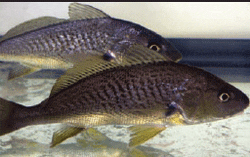
Growing saltwater fish, in Arkansas? The answer is maybe. For the last three years, the University of Arkansas at Pine has partnered with The University of Tennessee and Texas A&M University on a project funded by the USDA’s Southern Regional Aquaculture Center to develop croakers as an inland, low-salinity marine baitfish species. What’s a croaker you may ask? The Atlantic croaker Micropogonias undulatus is a candidate for multiple-purpose aquaculture production as a baitfish and foodfish. Atlantic croakers are a popular live baitfish for several saltwater recreational angling species such as spotted seatrout and red drum.
The Atlantic croaker is a U.S. native that occurs throughout the Atlantic and Gulf of Mexico from New York to Mexico. Atlantic croaker have the ability to utilize a multitude of food resources including plankton, detritus, plant material, small fish, and invertebrates, and they adapt well to manufactured diets. Atlantic croakers are capable of rapid growth with a short life-span of 2-4 years. Croakers have an extended spawning season from October to March. Mature croakers spawn in the open ocean, but high salinity is not necessary as they sexually mature and demonstrate advanced gonad development in brackish water ponds (2 to 6 ppt salinity). Croakers mature at a young age and small size, which are ideal traits for a baitfish species. Total length of croakers at first maturity is approximately 7 inches with more than 85 percent mature by the end of their first year.
Croakers are partial spawners, with eggs continuously matured and spawned throughout the spawning season. Fecundity for croakers ranges from 41,000 eggs per 7 inch female to 180,000 eggs for a 15 inch female.
Atlantic croaker production is still in its infancy and fundamental information on larval culture, nutrition, growout, economics and marketing is lacking. Significant strides have been made in reproducing Atlantic croaker on a large scale, and some progress has been made on the culture and feeding of juveniles to bait size.
Significant challenges remain in incubating eggs at high densities and culturing larvae. Growout systems and practices are not yet well defined, but growout practices could be similar to those for red drum. Culture may be limited by the ability to spawn croakers out-of-season to stock into fertilized rearing ponds so expensive live-food production in the hatchery can be avoided. Many unknowns still exist for croaker production and the feasibility of their culture in Arkansas remains uncertain. However, research is currently underway to address several of these gaps in production information.
Research spearheaded by UAPB has focused on development of reproductive and hatchery protocols and broodstock nutrition. Atlantic croaker broodstock measuring 8 inches or more can be obtained using various methods. Wild broodstock are easily pellet-trained using methods developed at UAPB. After pellet training, broodfish should be offered an 8 percent total lipid (6 percent menhaden fish oil), 45-50 percent protein diet at 4-6 percent of body weight per day. At UAPB, natural, ambient fall/winter water temperatures and photo-period have been used to accomplish spawning. Atlantic croaker in captive trials spawn the best under fall conditions at 10 hours of daylight/14 hours of darkness and a water temperature of 66ºF. Wild-captured Atlantic croaker will occasionally spawn passively when subjected to fall water temperature and photo-period conditioning. These voluntary spawning events tend to yield high fertilization rates, good hatching success, and fry survival. However, natural spawns tend to contain fewer eggs and the number of times each female spawns is low, leading to an overall reduction in fry produced compared to croakers induced to spawn using hormones. Additionally, natural spawning is asynchronous among females, occurring over a month or more, which reduces hatchery efficiency.
Reproduction of croakers was neglected until recently when new commercially available hormone treatments became available. Researchers at UAPB used hormone implants containing salmon Gonadotropin Releasing Hormone analogue (sGnRHa) to induce captive Atlantic croaker broodstock to spawn. A single implant injected under the skin when water temperatures fall to 70°F is effective for inducing spawning in Atlantic croaker. Using this method, female broodfish averaging 0.75 pounds and 11.4 inches) produce an average of five spawns and 265,000 eggs per female. In addition to elevated fecundity, the sGnRHa implant produces highly-synchronized spawning events with a four to six day spawning period. sGnRHa implants are not without their drawbacks. These implants are expensive ($10 per fish), may represent a biological overdose of GnRHa for fish of this size, and do not contain a dopamine blocker. This can result in poor milt production by males leading to reduced fertilization rates and over-hydration of eggs within females resulting in mortality.
Another spawning aid option investigated by UAPB is the lower-cost aqueous form of sGnRHa that contains a dopamine inhibitor. Atlantic croakers injected with aqueous sGnRHa/dopamine inhibitor at a rate of 0.23 cc/lb body weight at a water temperature of 72°F and photo-period of 10 hours of light have produced positive spawning results. These results include observation of males with free flowing milt by two days post-injection. Females injected with sGnRHa/dopamine inhibitor produce freely flowing eggs by two days post- injection and spawning begins around day three. Spawning continues from three to seven days post-injection with mean fertilization rates greater than 60 percent that decline over time. Mean hatch rate of fertilized eggs is often greater than 60 percent.
Several other research projects on spawning and rearing of Atlantic croaker are currently underway at UAPB. Recent developments include protocols to spawn Atlantic croaker out-of-season and refinement of lipid and protein amounts and sources in diets to improve fecundity of broodstock. Many hurdles must be overcome before commercial croaker production in Arkansas is realized, but it is not unrealistic to imagine that one day low-salinity marine baitfish production could be viable in Arkansas. For now, it remains a vision of a select few aquaculture researchers.
February 2012

